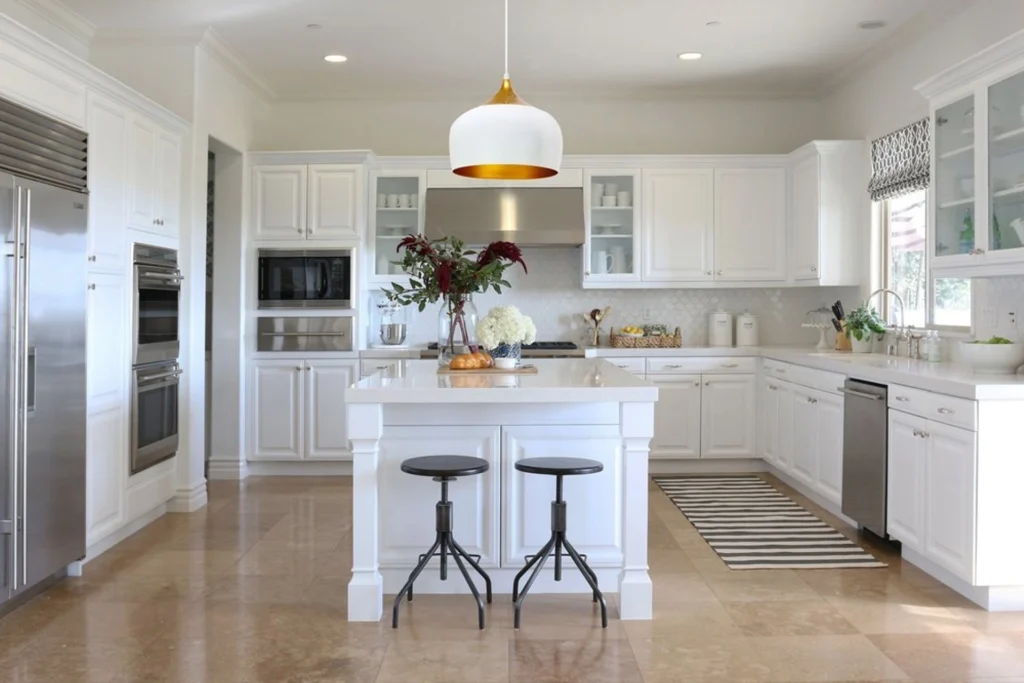Kitchen designer Fulham:
White kitchens have long been a favourite in interior design for their timeless appeal, brightness, and versatility. However, achieving a perfectly balanced white kitchen isn’t as simple as choosing white cabinets and countertops. A Professional Kitchen designer, Fulham, understands that white kitchens require meticulous planning, creative design strategies, and attention to detail to avoid appearing bland or sterile.
Understanding the Client’s Vision for a White Kitchen
Every kitchen design project begins with understanding the client’s preferences and lifestyle. When it comes to white kitchens, designers ask key questions:
- Do clients prefer a crisp, modern look or a warm, traditional style?
- How will the kitchen be used—primarily for cooking, entertaining, or both?
This initial consultation helps designers determine how to incorporate white into the kitchen in a way that reflects the homeowner’s personality while ensuring it’s functional.
Selecting the Right Shades of White
Contrary to what many think, white isn’t just one colour. Designers often work with dozens of shades—from cool, bluish whites to warm, creamy tones. Choosing the right white is essential because it sets the tone for the entire space.
Key considerations include:
Natural light:
In kitchens with ample sunlight, cooler whites can create a fresh and airy ambience. For darker spaces, warmer whites add a cosy feel.
Adjacent room colours:
The white chosen for the kitchen must complement the surrounding spaces to maintain flow.
Cabinet finishes:
Designers often mix matte and glossy finishes to avoid monotony.
This thoughtful selection prevents the kitchen from appearing too cold or too yellowed over time.
Creating Contrast and Depth
One challenge with all-white kitchens is avoiding a flat or sterile appearance.
Textures:
Using textured tiles for backsplashes, beadboard cabinetry, or natural wood elements.
Accent colours:
Introduce subtle accents, such as grey veining in marble countertops, black hardware, or stainless steel appliances.

Lighting fixtures:
Brass or matte black pendant lights can break up the sea of white and add a touch of personality.
Choosing Durable, Easy-to-Clean Materials
A common concern with white kitchens is that they show dirt, stains, and wear easily. Professional designers address this with material choices that are both practical and beautiful:
- Quartz countertops: Resistant to staining and easier to maintain than marble.
- Glossy cabinet finishes: Easier to wipe clean and reflect light beautifully.
- Ceramic or porcelain tiles: Ideal for floors and backsplashes because they resist spills and grime.
Balancing White with Natural Elements
To avoid a clinical feel, designers often balance white with natural elements. Wood accents, stone countertops, or greenery can introduce warmth and life to the space.
For example:
- Exposed wooden beams or oak shelving bring a rustic charm.
- Rattan barstools or wicker light fixtures add a soft touch to modern white interiors.
- Plants or fresh flowers add colour and vibrancy effortlessly.
This balance keeps the kitchen inviting and homely rather than overly minimal.
Lighting Design: Bringing Out the Best in White
Lighting plays a crucial role in white kitchen projects. Without proper lighting, even the most beautiful white kitchen can look dull or shadowy.
Designers layer lighting to create the right mood:
- Task lighting under cabinets for work surfaces.
- Ambient lighting, such as recessed ceiling lights, for overall brightness.
- Accent lighting with pendants or chandeliers as focal points.
They also consider the colour temperature of bulbs. Warm light adds cosiness, while cool light enhances crispness in modern white kitchens.
Personalising the Space
While a white kitchen provides a neutral canvas, designers know it’s important to personalise it so it doesn’t feel generic. Small but impactful touches might include:
- Unique cabinet hardware styles.
- Statement backsplashes in herringbone or Moroccan tile patterns.
- Open shelving styled with the homeowner’s favourite dishes or cookbooks.
These elements ensure the space feels custom and unique to the homeowner’s taste.
Addressing Long-Term Trends vs. Timelessness
White kitchens are popular, but designers guide clients on avoiding overcommitment to fleeting trends. Instead of all-white everything, they may recommend:
- Two-tone cabinetry with a darker colour on the island.
- Neutral-toned countertops that pair well with future colour changes.
- Flexible decor elements (like bar stools or light fixtures) that can be swapped out.
This approach provides homeowners with a kitchen that remains stylish for years without requiring major renovations.
Final Thoughts: The Designer’s Role in White Kitchens
Designing a White Kitchen Camden requires more expertise than meets the eye. Professionals ensure the space avoids common pitfalls, such as feeling too stark or impractical. They utilise thoughtful colour selection, clever contrasts, durable materials, and personalised touches to create a kitchen that is both functional and beautiful.
For homeowners dreaming of a white kitchen, working with a designer is the key to transforming that vision into a space that feels timeless, warm, and ideally suited to their needs.





